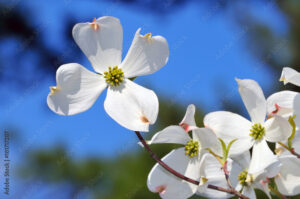Plant Information

Cornus florida, also known as flowering dogwood, is a native North American species of deciduous tree in the Cornaceae family. It is popular across its range, from southeastern Canada to northern Mexico, due to its beautiful petal-like bracts and its interesting bark. The hard wood likely inspired its genus name, which comes from the Latin cornu, meaning horn.
Flowering dogwood commonly grows in woodland margins, so it can be tricky to grow in a landscape setting. It requires full sun to partial shade and well-drained, highly organic, and slightly acidic soil. It may need more shade in hotter climates, and a layer of mulch can help keep the roots cool in the summer.
Flowering dogwood has multi-season interest with its beautiful spring bloom, scarlet fall foliage and red fruits, and its bark structure which is more visible in winter. Dogwood flowers are pollinated by butterflies and bees, and its fruits provide an important food source for songbirds in fall and winter, making it great for supporting local wildlife.
This tree has historically been useful to humans as well. Native Americans used the bark and roots as a remedy for malaria, and they extracted red dye from the roots. The hard wood was useful for making weaving-shuttles, spools, pulleys, mallet heads, and jeweler’s blocks, and the bark was used to treat dogs with for mange, which may be how the tree got its common name.
Economics
According to the USDA NASS Census of Horticulture, dogwoods sold for a value of $28 million in 2014 and $31 million in 2019.
Main Diseases Problems
Flowering dogwoods can suffer from several bacterial and fungal diseases: dogwood anthracnose, powdery mildew, Elsinoë leaf spot, Septoria leaf spot, leaf and flower blight, and crown canker.
Main Pest Problems
Dogwoods can also be targeted by several pests: dogwood sawflies, dogwood borers, flatheaded appletree borers, aphids, scales, leafhoppers, mealybugs, and whiteflies.
IR-4 Research
IR-4 has worked to develop efficacy information on problems that affect dogwoods, such as Colletotrichum sp. and Asian ambrosia beetles. Additionally, IR-4 has conducted 46 crop safety trials to determine if products cause any harm or leave unsightly residues on flowering dogwoods.
Authors
Laura Werner, IR-4 Environmental Horticulture Program Research Assistant
References
https://en.wikipedia.org/wiki/Cornus_florida
https://plants.ces.ncsu.edu/plants/cornus-florida/
https://www.wildflower.org/plants/result.php?id_plant=cofl2
https://extension.umd.edu/resource/key-common-problems-dogwoods
https://extension.psu.edu/dogwood-diseases
https://ipm.ucanr.edu/PMG/GARDEN/PLANTS/dogwood.html
https://quickstats.nass.usda.gov/
